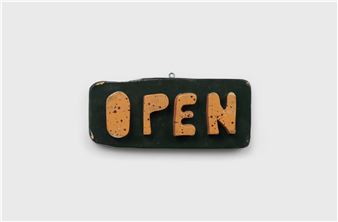Utopia Dystopia: The Myth of Progress Seen From the South
Conceived in relation to the MadreÔÇÖs collection and including works by 55 Italian and international artists, Utopia Dystopia: the myth of progress seen from the South investigates contemporary practices that have responded to the massive social changes of the last half century: urbanization, industrialization, the creation of new urban peripheries, the demographic transformation of rural space, struggles related to bodily choices, freedoms and constraints.
The exhibition proposes an analysis of the utopian promises and dystopian experiences of modernity, with particular attention to southern Italy, as well as to the representation of the substantial failure of the violent logics underpinning economic progress ÔÇô the failure also of an overextended system, as experienced over the last year of the Covid-19 pandemic. From Mimmo JodiceÔÇÖs sharp observations of the urban periphery, industrial architectures and southern landscapes in the Sixties and the Seventies, to Antonio BiasiucciÔÇÖs photographic tributes to abandoned villages and pastoral life in Campania, to Raffaela MarinielloÔÇÖs and Ibrahim MahamaÔÇÖs investigations of the industrial space of Bagnoli, with its powerful and toxic beauty. Also explored across six sections ÔÇô Urban Space, Rural Space, Peripheral Space, Industrial Space, Extraterritorial Space and the Space of the Body ÔÇô is the potential through artistic intervention to open spaces of transformation within dystopian realities, and to create alternatives. Joseph Beuys wrote on the poster for his 1971 exhibition in Naples (created on the basis of a photographic work on show here): ÔÇÿThe revolution is usÔÇÖ.
The modern ideology of progress affirmed the ability of human beings to reshape their lives and environments with the help of technology and science, creating new infrastructure and providing access to medical services, education and waged labor. New choices and freedoms were promised to women and others that had been historically marginalized or economically disadvantaged. Many rather found themselves isolated in the suburbs, in small households and with precarious, poorly paid and often dangerous work. The creation of utopian spaces for knowledge sharing and artistic experimentation in the periphery animated several artists in the Neapolitan context from as early as the late sixties. The work of Riccardo Dalisi, who collaborated with the artisans and young people of Rione Traiano, was exemplary in this regard. In the same period, Tomaso Binga interpreted through her artistic work the dominant media vision of women as sexual objects, far from the independence and respect declared by a society that proclaimed itself progressive. A large number of artists have sought a way out of an apparent systemic dead end, questioning, in historical perspective, the established order and accepted norms.
From the period of the unification of Italy, often experienced as the undue imposition of a northern economic and social system, the existence of a devalued and exploited south needing to reaffirm itself has been underlined, as Giulio Delv├¿ÔÇÖs work in the exhibition, Viva il Brigantaggio, reminds us. Progress and the economic system of capital growth require constant expansion, cheap labor, and new resources. The collaborating duo Bianco-Valente work with various communities in regard to the effects in the Mezzogiorno of this system, which has led to the expropriation of land, migration to the north and the big cities, with the ensuing loss of roots, cultural identity and memory. French sociologist Pierre Bourdieu has defined neoliberalism as ÔÇÿa program designed to destroy collective structures capable of obstructing pure market logicÔÇÖ (Le Monde diplomatique, December 1998). The south nonetheless asserts itself as a territory where these structures and values are preserved and where the extreme beauty and fragility of existence are still collectively celebrated: a territory where another future can be imagined.

Recommended for you
Conceived in relation to the MadreÔÇÖs collection and including works by 55 Italian and international artists, Utopia Dystopia: the myth of progress seen from the South investigates contemporary practices that have responded to the massive social changes of the last half century: urbanization, industrialization, the creation of new urban peripheries, the demographic transformation of rural space, struggles related to bodily choices, freedoms and constraints.
The exhibition proposes an analysis of the utopian promises and dystopian experiences of modernity, with particular attention to southern Italy, as well as to the representation of the substantial failure of the violent logics underpinning economic progress ÔÇô the failure also of an overextended system, as experienced over the last year of the Covid-19 pandemic. From Mimmo JodiceÔÇÖs sharp observations of the urban periphery, industrial architectures and southern landscapes in the Sixties and the Seventies, to Antonio BiasiucciÔÇÖs photographic tributes to abandoned villages and pastoral life in Campania, to Raffaela MarinielloÔÇÖs and Ibrahim MahamaÔÇÖs investigations of the industrial space of Bagnoli, with its powerful and toxic beauty. Also explored across six sections ÔÇô Urban Space, Rural Space, Peripheral Space, Industrial Space, Extraterritorial Space and the Space of the Body ÔÇô is the potential through artistic intervention to open spaces of transformation within dystopian realities, and to create alternatives. Joseph Beuys wrote on the poster for his 1971 exhibition in Naples (created on the basis of a photographic work on show here): ÔÇÿThe revolution is usÔÇÖ.
The modern ideology of progress affirmed the ability of human beings to reshape their lives and environments with the help of technology and science, creating new infrastructure and providing access to medical services, education and waged labor. New choices and freedoms were promised to women and others that had been historically marginalized or economically disadvantaged. Many rather found themselves isolated in the suburbs, in small households and with precarious, poorly paid and often dangerous work. The creation of utopian spaces for knowledge sharing and artistic experimentation in the periphery animated several artists in the Neapolitan context from as early as the late sixties. The work of Riccardo Dalisi, who collaborated with the artisans and young people of Rione Traiano, was exemplary in this regard. In the same period, Tomaso Binga interpreted through her artistic work the dominant media vision of women as sexual objects, far from the independence and respect declared by a society that proclaimed itself progressive. A large number of artists have sought a way out of an apparent systemic dead end, questioning, in historical perspective, the established order and accepted norms.
From the period of the unification of Italy, often experienced as the undue imposition of a northern economic and social system, the existence of a devalued and exploited south needing to reaffirm itself has been underlined, as Giulio Delv├¿ÔÇÖs work in the exhibition, Viva il Brigantaggio, reminds us. Progress and the economic system of capital growth require constant expansion, cheap labor, and new resources. The collaborating duo Bianco-Valente work with various communities in regard to the effects in the Mezzogiorno of this system, which has led to the expropriation of land, migration to the north and the big cities, with the ensuing loss of roots, cultural identity and memory. French sociologist Pierre Bourdieu has defined neoliberalism as ÔÇÿa program designed to destroy collective structures capable of obstructing pure market logicÔÇÖ (Le Monde diplomatique, December 1998). The south nonetheless asserts itself as a territory where these structures and values are preserved and where the extreme beauty and fragility of existence are still collectively celebrated: a territory where another future can be imagined.
Artists on show
- Alexandre da Cunha
- Annalisa Ramondino
- Antonio Biasiucci
- Athena Papadopoulos
- Baldo Diodato
- Betty Bee
- Bianco - Valente
- Bruna Esposito
- Catherine Opie
- Cherubino Gambardella
- Danilo Correale
- David Kelley
- Désirée Klein
- Didi Gnocchi
- Domenico Antonio Mancini
- Eduardo Castaldo
- Eugenio Giliberti
- Eugenio Tibaldi
- Felice Pignataro
- Francesco Arena
- Francesco Arena
- Francesco Rosi
- Franco Silvestro
- Giulia Piscitelli
- Giulio Delvè
- Giulio Paolini
- Goldschmied & Chiari
- Gruppo XX
- Ibrahim Mahama
- John Dileva Halpern
- Joseph Beuys
- Justin Randolph Thompson
- Kiluanji Kia Henda
- Lina Mangiacapre
- Margherita Moscardini
- Maria Adele Del Vecchio
- Maria Lai
- Mathilde Rosier
- Matteo Antonelli
- Melita Rotondo
- Michele Iodice
- Mimmo Jodice
- Monica Biancardi
- Paolo Puddu
- Patty Chang
- Perino & Vele
- Raffaela Marinello
- Raffaela Naldi Rossano
- Rebecca Horn
- Riccardo Dalisi
- Romina De Novellis
- Rosy Rox
- Roxy in the Box
- Salvatore Emblema
- Temitayo Ogunbiyi
- Tomaso Binga
- Tonino Casula
- Umberto Manzo
Contact details


 ARTISTS
ARTISTS















